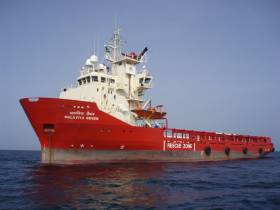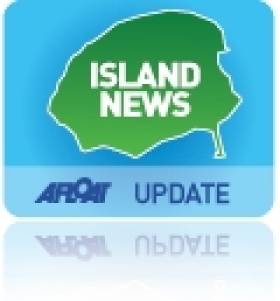Displaying items by tag: Dominic J Daly
Cork Marine Auctioneer Appointed To Sell Supply Vessel In Aberdeen
#PublicAuction - Dominic J Daly’s success as a marine auctioneer in Cork has not gone unnoticed overseas — as the Sheriff of Aberdeen in Scotland has sought his services to auction a detained supply vessel.
The Indian-registered MV Malaviya Seven, formerly the Norther Clipper, is an 82.5m vessel built in Norway in 1994 to supply oil and gas platforms.
It was detained by the Maritime and Coastguard Agency in March for the third time in 12 months over non-payment of wages to its crew, according to Offshore Energy Today.
The vessel will be put up for Public Auction at 12 noon on Tuesday 17 October at the Rox Hotel in Aberdeen. The vessel is offered for sale as seen as is at Aberdeen Port.
Details of the MV Malaviya Seven include a very extensive bridge and other navigational equipment, two Ulstein Bergen BRM-8 engines with 9,600 BHP, and 1,208 registered tonnage.
Further details and conditions of sale are available from Dominic J Daly, Frics, Auctioneer, Pembroke House, Pembroke Street, Cork (Phone: (353) 21 4277399; Mobile: (353) 87 2550486; Email: [email protected]) or from the PDF available to download below.
Drug Yacht Makaybella To Be Auctioned In Cork
#makaybella – A 62–ft custom cruising sailboat, the SY Makaybella, is to be auctioned in Cork at the end of this month. The sailing yacht was seized last September by the Irish Navy after it was intercepted in the Atlantic about 200 miles (322km) off the south west coast of Ireland.
As Afloat.ie reported last September, the sea raid followed a covert surveillance operation to track the 60ft yacht from Venezuela.
A haul of 41 bales of cocaine discovered onboard was initially valued at €80m but such was the purity of the drugs at 70pc it was re–estimated to have a street value of around €350m.
Intelligence sources said it was understood the drugs were heading for the north Wales coast.
The yacht is now for sale 'as seen as is' at Haulbowline in Cork Harbour under the direction of An Garda Siochana.
The 28–year–old yacht will be auctioned – unless previously sold – at 12 noon on Thursday, 30th July at the Carrigaline Court Hotel, Carrigaline, Co. Cork.
The auctioneer is Dominic J. Daly & Co Pembroke House Tel: 021 – 4277399 Email: [email protected]
More details on the yacht here
#navy – Cork Auctioneer Dominic Daly is to sell the Navy Vessel LE Emer (P21) in early October. The Auctioneer, who recently handled the public auction of the Clipper Faith Cargo vessel for the Admiralty Marshall, confirmed arrangements are now in place with the Department of Defence to dispose of the ship this Autumn. Interest could come from a variety of sources including the conversion of the ships for the superyacht market or use as an offshore energy supply boat or a research vessel.
A year later the sister ship LE Aoife (P22) will also go on the market. Both ships are being replaced with new builds for the Irish Naval Service.
As Afloat.ie reported in May, the two Irish-built navy patrol ships launched at Verolme Cork Dockyard, are to be sold off after 40 years of service.
LE Emer (P21) and a sister ship LE Aoife (P22) were built between 1978 and 1980 at the Rushbrooke shipyard near in Cobh, Co Cork.
The first ship of four in the Offshore Patrol Vessel (OPV) class built in Cork in 1972, the LE Deirdre (P20) , was decommissioned in 2001 and sold for €190,000. She was later converted into a luxury yacht.
The two ships will be replaced by two new OPVs currently under construction in the UK.
Aran Island Fast-Ferries Sold to Mauritius Operator
The sale follows a previous attempt to dispose of the 234-passenger capacity ferries at an auction in Galway last month. Despite bids reaching €950,000, they were withdrawn at the auction which was also hosted by the Cork based auctioneer.
The vessels remain in Rossaveal but they will be transferred onto a cargoship as 'deck-cargo' to make the long delivery journey across the high seas for the new owners. Mauritius is neighboured by the smaller islands of Agalega, Cargados Carajos and Rodrigues which together form the Mascarene Islands, with the French island of Réunion some 200km to the southwest.

Sisters Clann na nOileáin and Clann Eagle I moored at Rossaveal. Photo
Jehan Ashmore / ShipSNAPS
With a streamlined aluminium 26m mono-hull design the vessels are capable of 19.7 knots. When the craft were constructed in 2006 they were worth between €5 and €6m. The pair were built in France by the OCEA boatyard at Les Sables d'Olonne, on the Bay of Biscay coastline, for Bád Arann Teo (trading as Aran Direct).
The company which went into receivership, operated on routes between Rossaveal and the Aran Islands (Oileáin Árann) of Inishmore (Inis Mór) Inishmaan (Inis Meáin) and Inisheer (Inis Oírr).
In recent years, Aran Direct had intended to introduce a larger passenger-only catamaran ferry on a new route between Galway and Kilronan, the capital of Inishmore and the largest of the three islands.
The fast-craft catamaran envisaged for the route was the U.S. based, 37m Harbour Lynx (2003/427grt) formerly Angel of Freedom, with a capacity for 300 passengers.To be renamed Aran Princess, the vessel was scheduled to take only an hour's passage time across Galway Bay.
In addition the revived route would have been the first direct 'passenger' carrying link between Galway City to the Aran Islands, since the closure in 1988 by CIE (Córas Iompair Éireann) of the three-hour route operated by the Naomh Éanna (1957/438grt).
Auction of Aran Islands Passenger Ferry Sisters
Aran Direct (which was the trading name for Bád Arann Teoranta) operated on routes between Rossaveal to Inis Mór, Inis Meáin and Inis Oírr. The company competed in an intensely competitive market with at least 10 other vessels combined from the fleets of Aran Doolin Ferries, Aran Island Ferries and the Doolin Ferry Company.
In September 2008, Aran Direct ceased operations and the vessels were laid-up at Rossaveal, where they remain, as seen (if not previously sold) prior to the public auction.
At the instructions of Liam Dowdall Esq., Receiver & Manager, Bád Arann Teoranta (in receivership), the vessels are to be sold in one or separate lots. The public auction is to be held at 12 noon on Thursday 24th February at the Harbour Hotel, The Docks, Galway.
An outline of the vessels details can be downloaded in PDF format by clicking HERE. For further details, photographs and conditions of sale contact Dominic J. Daly, Auctioneer, Cork Tel: (021) 4277399 or E-mail: [email protected] and logging on to www.dominicjdaly.com
For further technical details, you can contact Noel O'Regan of Promara Ltd on 087 3435666 or email [email protected]

































































